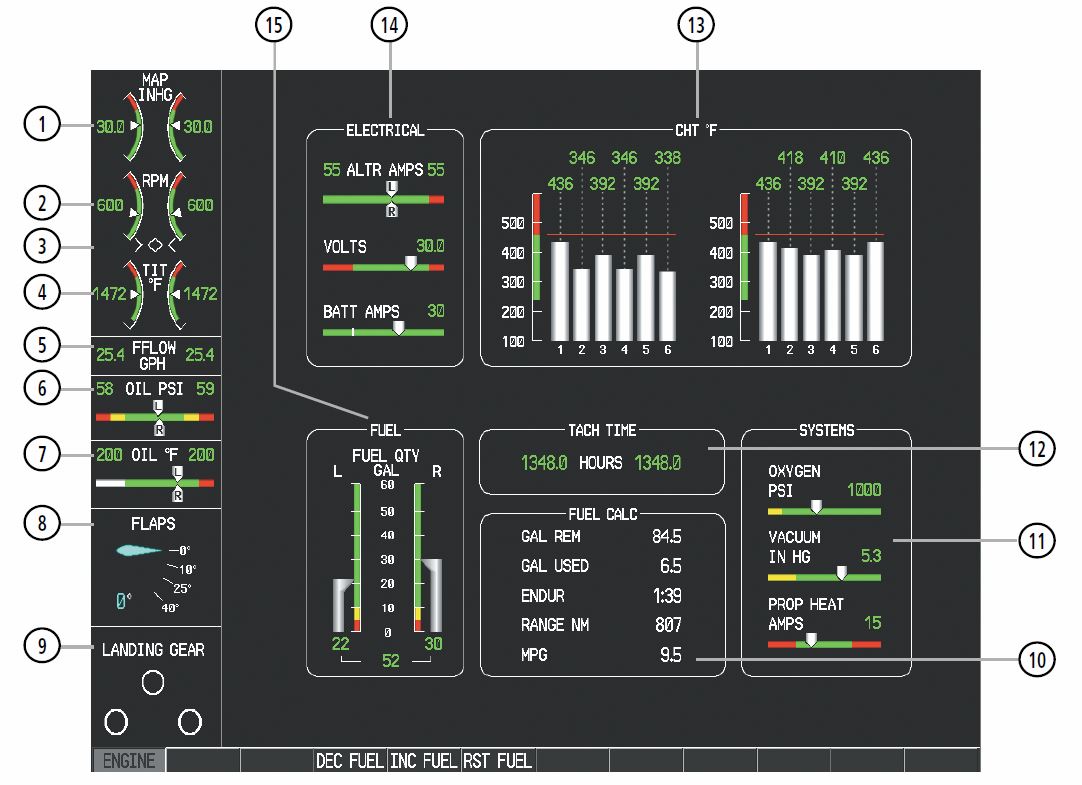BACKGROUND
The Seneca V Engine page on the G1000 MFD displays information on individual Cylinder Head Temperatures (CHTs) and Turbine Inlet Temperatures (TITs). Earlier models of the Seneca displayed Exhaust Gas Temperatures (EGTs), but this is not the case on the Seneca V. EGT is the temperature of the gas leaving the engine and TIT is its temperature entering the turbo-charger; whilst they are very similar, they are not quite the same thing.
As an engine burns fuel, it provides power to drive the pistons, but it also produces lots of excess heat that increases the temperature of the cylinder heads. Allowing even a single cylinder head to get too hot can quickly damage an engine, so the Seneca V provides a CHT reading for each individual cylinder, which is a much better engine monitoring system than was available on previous models. There are several ways to manage the CHTs, but although the maximum value (the horizontal red line at item 13 pictured below) for the Seneca V is 460⁰F, the POH advises that it should be maintained below 420⁰F to increase engine life.
By contrast, a high EGT does not indicate that the engine itself is under excessive stress or represent a threat to engine longevity. So the actual value of EGT is unimportant to the engine, it simply indicates that a lot of energy from the fuel is being wasted out of the engine exhaust. A very useful article on monitoring EGT can be read at EGT Myths Debunked.
On turbo-charged engines, such as those fitted to the Seneca V, the engine exhaust immediately enters a turbo-charger so that waste energy from the exhaust can be used to compress air entering the engine manifold and increase the power output from the engine. Since the fast-spinning turbine wheel of a turbo-charger can easily be over-heated and damaged by the resulting blade-stretch, turbo-chargers do need to be protected against excessive engine exhaust temperatures. So it is much more important to accurately measure the gas temperature as it enters the turbo-charger, the TIT, than as it leaves the engine, the EGT. The normal maximum TIT on the Seneca V is 1650⁰F, because that is the maximum temperature of gas that the turbo-charger can tolerate.
LEANING THE MIXTURE – THE TEXTBOOK TECHNIQUE
The EGT, and hence the TIT, is greatly affected by the fuel mixture. Peak EGT for any given power selection occurs at approximately the “stoichiometric” (chemically correct) fuel mixture of 14.7 pounds of air for each pound of fuel, at which point there is exactly the right amount of oxygen to oxidize all the hydrocarbon chains in the fuel. Leaner mixtures cause the EGT to decrease simply because less fuel produces less energy. Richer mixtures also cause EGT to decrease because excess (un-oxidized) fuel absorbs heat energy when it vaporizes. Consequently, peak EGT (or TIT on the Seneca V) can be used to identify an efficient stoichiometric mixture, and decreases in temperature from the peak value can be used to establish mixtures richer or leaner than stoichiometric.
However, changing the mixture will also affect the CHT because doing so varies the rate at which the air-fuel mixture burns. Varying the burn rate will cause a change in the moment at which the peak internal cylinder pressure and temperature occurs during the power stroke, and this affects how much of the heat energy is transferred to the cylinder heads. The CHT will stabilise at its highest value when the burn rate of the air-fuel charge is at its fastest; and this occurs when the mixture is slightly richer than stoichiometric – at approximately 50°F Rich-Of-Peak EGT. Either richening or leaning the mixture from that point decreases the burn rate and causes a reduction in CHT.
The Seneca V POH advises that the mixture should be “Leaned to peak TIT” during the cruise. Leaning to peak TIT, rather than to 50°F Rich-Of-Peak, should produce a slightly higher TIT during the cruise, but will also slightly reduce the CHTs from their maximum values attained when running at just Rich-Of-Peak. The POH permits you to exceed the maximum TIT (1650⁰F) by 50⁰F for up to 60 seconds in order to determine the peak TIT, but experience has shown that the TIT rarely peaks above 1500⁰F in the UK.
However, when adjusting the mixture setting, it is essential that the CHT is also monitored as this is the best reference measurement available to assess the stress within the engine itself. Remember that, although the maximum CHT published for the Seneca V is 460⁰F, the POH advises that it is kept below 420⁰F to increase engine life; moreover, it takes several minutes for the CHT readings to stabilise. The mixture should not be leaned beyond the point at which any one of the six CHTs increases to 420⁰F.
To summarise, CHTs must be monitored when leaning the engines as excessive CHTs will damage the engine; excessive TITs will damage the turbos. As long as all of the CHTs remain below 420⁰F, the mixture should be set to the point at which the TIT peaks, usually at about 10 Gals/Hr, as long as it remains below 1650⁰F. If the mixture were then to be richened slightly so that the TIT decreases by 50°F, the CHTs would increase to their maximum possible value for that power setting which places additional stress on the engine.
LEANING THE MIXTURE – THE PRACTICAL TECHNIQUE
Unfortunately, leaning the mixture as described above takes time and concentration. The TITs and CHTs do not move instantaneously and can take some minutes to settle down as you attempt to find the peak TIT. As the legs flown will be short and your workload will be high during the course, the CFI has directed that we can use the following rapid technique to lean the mixtures at the top-of-climb:
- Once the MAPs and RPMs have been set, select the MFD to the ENG page if not already selected.
- Using the Fuel Flow gauges, lean the mixtures on each engine to approximately 12 Gals/Hr.
- Allow the engines to stabilize.
- As the engines will be running slightly richer than peak, ensure that all CHTs remain below 420⁰F.
- Ensure that the TITs remain below 1650⁰F.
Re-select the mixtures to Rich when carrying out General Handling or if greater than High Speed Cruise power setting (2500 RPM and 30” MAP) is required.















